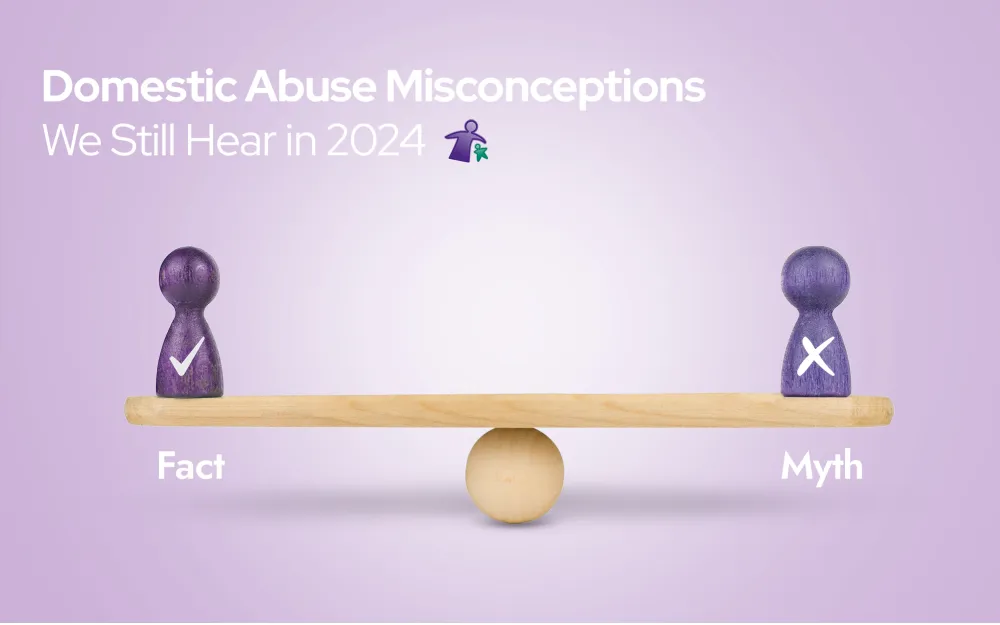
Over the past 50 years, we have seen a shift in attitudes towards domestic abuse, which has led to it becoming an issue that is talked about a lot more openly. Despite this, we still hear some common misconceptions about what domestic abuse is and who is impacted by it.
Here are 5 examples that we have seen or heard – there are often many more though.
1. Domestic Abuse Is Always Physical
Domestic abuse can take many forms, including but not limited to physical violence. There are many other forms of abuse included in the definition of domestic abuse, which was legally defined by the Domestic Abuse Act. The Act says:
“Behaviour is “abusive” if it consists of any of the following: physical or sexual abuse, violent or threatening behaviour, controlling or coercive behaviour, economic abuse, psychological, emotional or other abuse.”
The most recent Office for National Statistics (ONS) survey actually found that 88% of those that experienced domestic abuse had primarily experienced non-physical abuse.
2. Why Don’t They Just Leave?
This is a common question, but we think the real question should be “why doesn’t the perpetrator stop?” Perpetrators choose to behave in this way and must be held accountable for their behaviour, instead of placing the onus on a survivor to make the change.
There are many barriers that prevent a survivor from accessing support, whether that is not wanting to unsettle their children, fears of not being believed, or concerns around supporting themselves financially – an increasingly common factor as living costs rise. These factors impact someone’s decision to leave, making it a lot more difficult than it may seem.
3. Domestic Abuse Doesn’t Impact Me
At Leeway, we believe that domestic abuse is everyone’s business, even if you do not have direct experience of it. Statistics show that 1 in 3 women and 1 in 5 men will experience domestic abuse in their lifetime – meaning it is quite likely that someone in your family or friendship group will experience it in their lifetime.
By talking openly about issues like domestic abuse, it helps to break down the barriers that make it so hard for those experiencing it to come forward for support. We all have a role to play to look out for each other and do our bit to raise awareness.
4. It’s Fine For Your Partner To Control Your Finances
This is not ok and is actually a form of domestic abuse. It is financial abuse – a tactic often used by perpetrators to make their partner dependent on them and withdrawn from friends and family.
It may be that they monitor how you spend your money or even control it entirely, not giving you money to buy new clothes or go out with friends.
Financial abuse has been highlighted over the past few years as the rising cost of living impacts people across the country, especially those experiencing domestic abuse.
5. Nothing Can Be Done To Stop Domestic Abuse
Whilst it is sadly unlikely that we will completely eradicate domestic abuse, there are many things that can be done to reduce its prevalence and help people experiencing it to get support at an earlier stage.
Whether that is training professionals to be able to spot the signs of domestic abuse or working with young people to highlight the importance of healthy relationships, greater awareness helps to increase understanding of domestic abuse.
Ensuring that long-term funding is available to tackle domestic abuse is also important – Women’s Aid’s research has found that investing £427m every year would actually save the UK as much as £23bn per year.
There is still so much that can be done to tackle domestic abuse and we are extremely grateful for all the support that we receive.
Leeway has a comprehensive domestic abuse awareness training programme. For details of upcoming courses, email admin@leewaynwa.org.uk